FAQ
When is a structural calculation required for your shelter?
8 min reading time
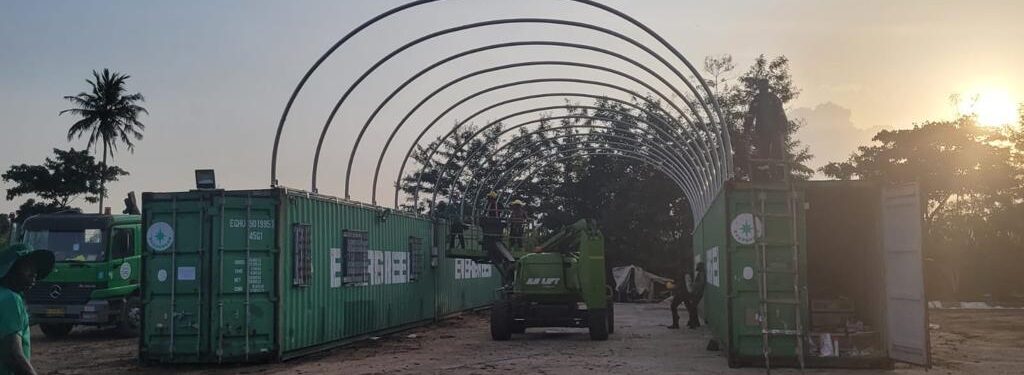
You need temporary or semi-permanent storage space quickly. Kroftman is the right place to go. In addition to our self-build storage buildings, we've been selling container shelters and warehouse tents for over 15 years. These are various quick and budget-friendly solutions that allow you to create temporary storage or workspaces in no time. But which storage solution is the best fit for you? In this blog, we compare container shelters with tent-based solutions. Here's a quick comparison of these three products on 13 key points. We also cover the following:
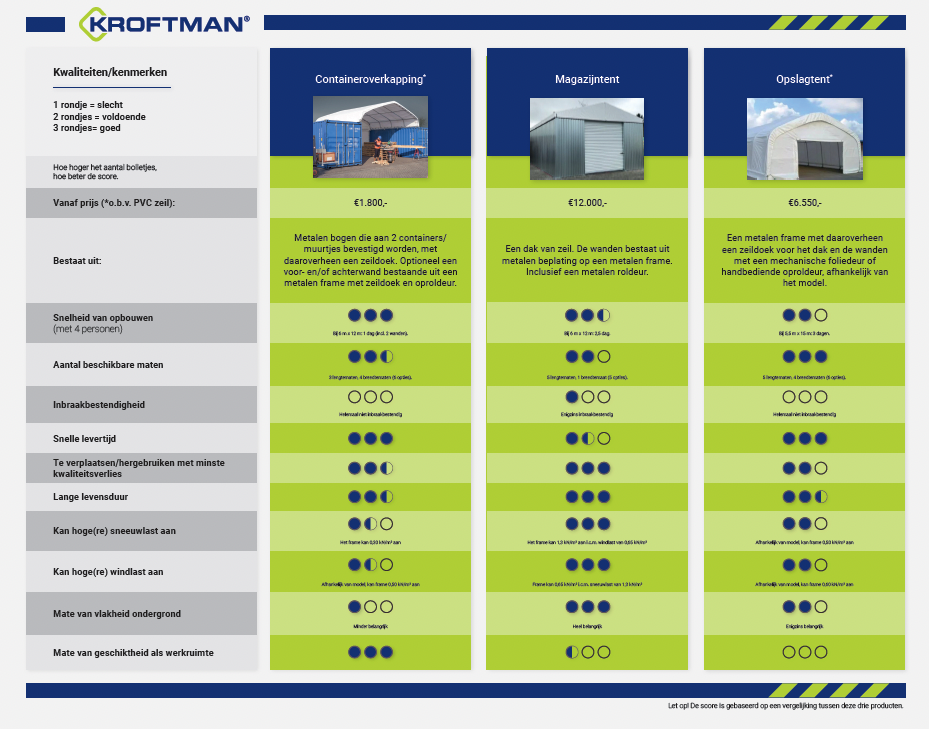
Based on the above schema, we can't determine which of the three storage solutions is 'the best.' They all have pros and cons when compared to each other. Below, we further explain the advantages and disadvantages. Both in the table above and in the comparisons below, we assume the use of the stronger (and more expensive) PVC tarp for the container shelter and the warehouse tent. We also compare the three storage solutions relative to each other.
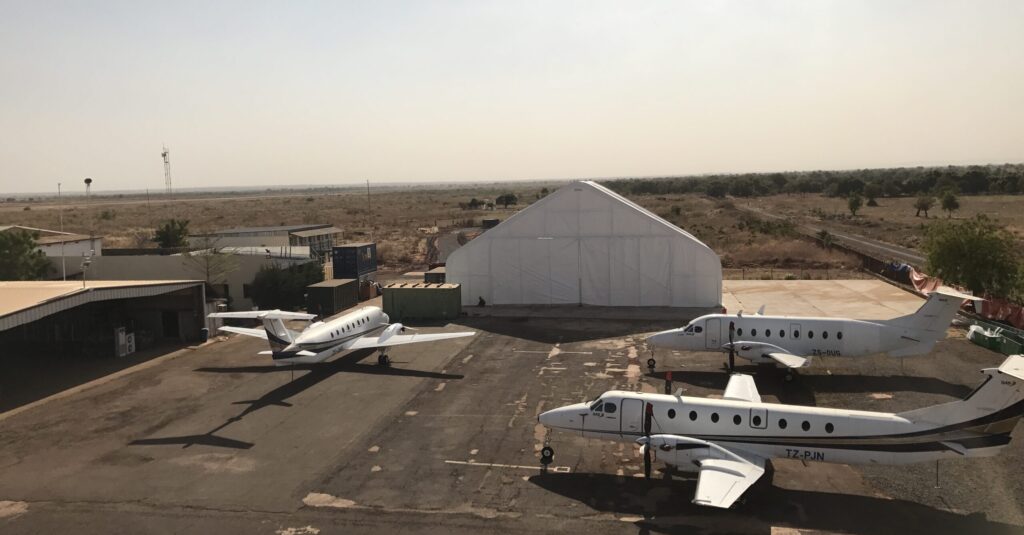
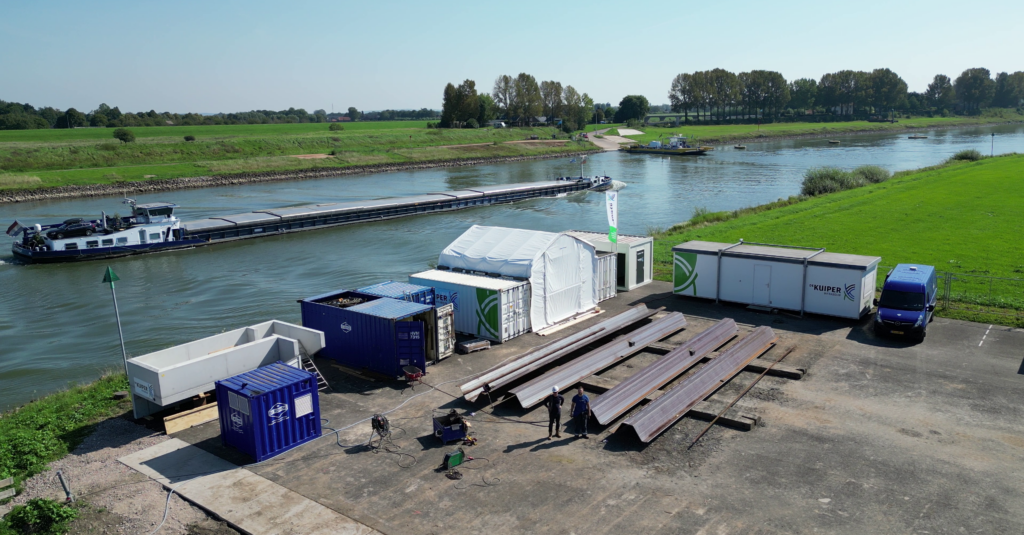
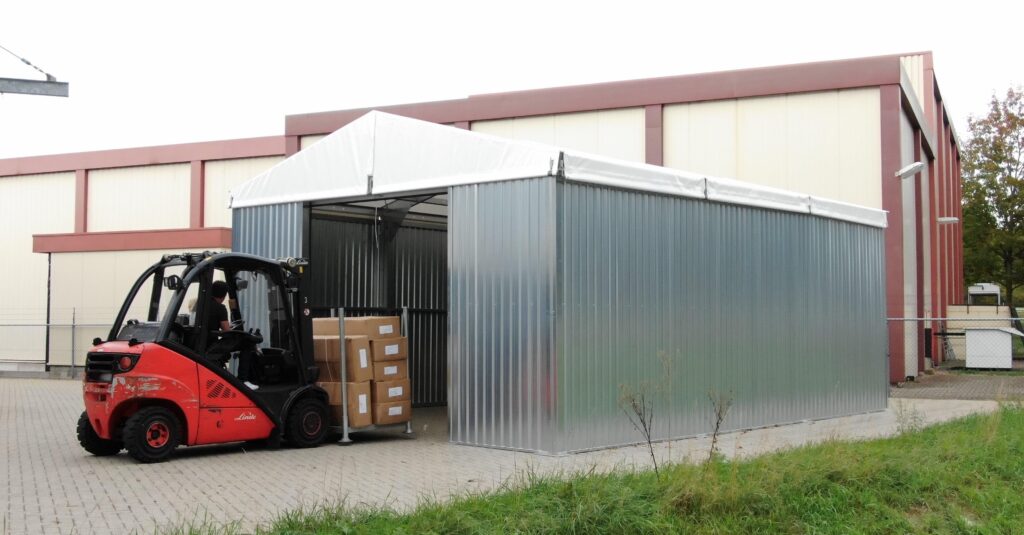
The significant advantage of a container shelter is that you create a covered workspace and simultaneously have storage space for your materials, protected from sun, wind, and precipitation. If you mount the container shelter on two containers, you can also use the containers as additional, lockable storage space. In practice, container shelters are often used as sawing sheds or work shelters at long-term construction projects. The tent-based solutions, on the other hand, are designed solely for storing items, not for workspaces.
Another advantage is the quick assembly of a container shelter. Kroftman has developed special mounting clamps for attaching a container shelter. With these clamps, you achieve the shortest assembly time and a guaranteed solid anchoring of the container shelter without damaging your containers.
Our container shelters offer more width options than our warehouse tents. You can choose from four different widths (4, 6, 8, 10 and 12 meters). Each width has a standard length option, and sometimes you can choose from two lengths. In total, there are three different length options (3, 6, and 12 meters), with the width determining which length options are available. Other customizable options include:
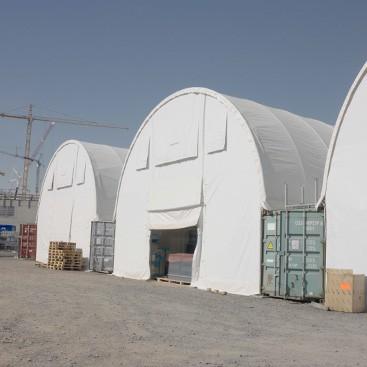
You always need two containers or two (concrete) walls to mount the container shelter on. The warehouse tents and storage tents can be placed wherever you want, as they have their own frames.
Speaking of frames, the container shelter frame has the lowest snow load of the three. It can carry a maximum of 30 kg per m². This shouldn't be a problem if you keep the roof snow-free in the winter.
Our warehouse tent is a combination of a storage building and a storage tent. The roof consists of PVC tarp, and the structure comprises steel cold-rolled C-profiles. The walls use non-insulated corrugated steel sheets, similar to those of our non-insulated self-build storage buildings, but without a topcoat. This prevents paint damage from repeated assembly and disassembly. There is also a difference in assembly. For a warehouse tent, fewer screws are used to attach the panels to the structure than in a storage building. Screws are only placed in the middle of the panel. Using fewer screws reduces the number of screw holes when dismantling and reassembling the warehouse tent. The warehouse tent can be dismantled without damage. The metal panels are sturdy, and the tarp is not stretched over a metal frame but is slid through an aluminum keder profile, as seen in the photos below. This prevents the tarp from flapping against the frame, reducing wear and tear. Thus, the warehouse tent can be relocated multiple times or resold with a high residual value.
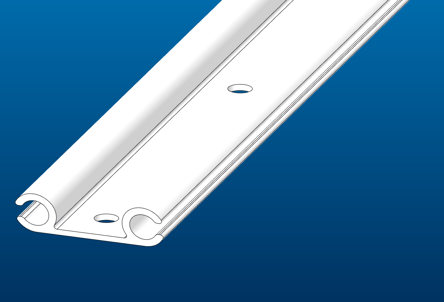
Keder profile
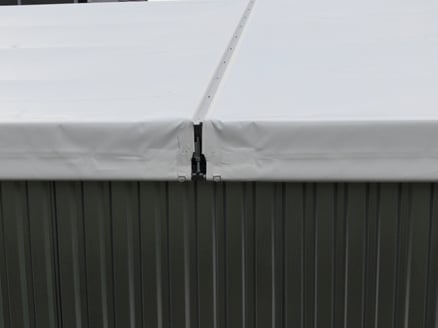
Tarp in keder profile
The structure of the warehouse tent can handle a snow load of up to 130 kg of snow per square meter. This makes the warehouse tent suitable for a permanent building permit in almost all of Europe. Note that the snow load refers to the structure of the warehouse tent. The roof consists of tarp, so it's best to keep it snow-free. The white PVC tarp allows a lot of natural light in, providing good daylight entry.
The warehouse tent has fewer size options compared to a container shelter or storage tent. Our warehouse tent is always six meters wide. You can extend the warehouse tent in increments of 2.86 meters. You can choose the type of anchoring, ground anchors for any hard surface, or concrete anchors if you're placing the warehouse tent on concrete slabs. There's also the option for an extra roll-up door in the back wall. Beyond this, we don't offer additional options for a warehouse tent. Each warehouse tent has the color scheme you see in the photos because the panels have no topcoat. The shiny color will become duller over time, but this doesn't affect quality. The acquisition cost of a warehouse tent is significantly higher than that of a storage tent or container shelter. Additionally, the warehouse tent has the longest delivery time, averaging four weeks, while the container shelter and storage tent are available for immediate shipment.
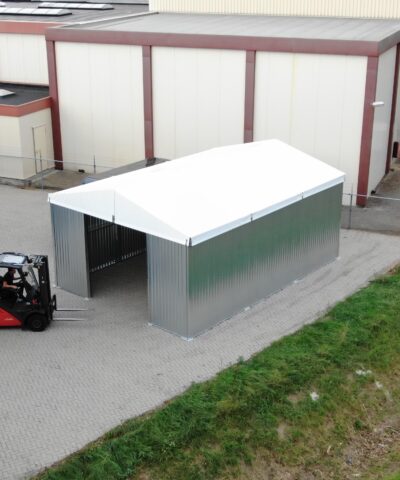
A storage tent consists of a structure of round galvanized steel pipes with a tarp stretched over it. It can have a mechanical foil door or a manually roll-up door, depending on the model. A storage tent is cheaper than a warehouse tent and slightly more expensive than a container shelter. The advantage over a container shelter is that you don't need containers or walls to mount it on. The storage tent has its own frame and can be placed anywhere. Some models also allow for the installation of one or more pedestrian doors in addition to the foil or roll-up door. A storage tent can be dismantled and rebuilt relatively easily. However, the tarp quality will diminish over time, especially with frequent assembly and disassembly. Storage tents are often used for temporary storage solutions or when extra storage is only needed for a specific season. In such cases, a storage tent is ideal. After use, you can store the tent and rebuild it next year.
Our storage tents offer more width options than our warehouse tents. You can choose from four different widths (5.5 meters, 7.9 meters, 9.2 meters, and 12.2 meters). Each width has a standard length, with sometimes a choice between two lengths. There are a total of five length options, ranging from 12 meters to a maximum of 25 meters. The width determines which length options are available. Other customizable options include:
A significant advantage of a storage tent is its short delivery time. Like the container shelter, we can ship these from stock. If you're able to pick up the storage tent yourself, for example, with a trailer, you can pay for the tent and take it with you immediately.
A storage tent is a tent. It cannot be insulated and is sensitive to temperature fluctuations, leading to condensation. This also applies to the warehouse tent. The container shelter has slightly less condensation. The tarp of the front and rear walls of a container shelter has overpressure openings with wind-breaking mesh to prevent the structure from blowing away. This provides more air circulation than in a storage tent. Another downside is vulnerability to theft. A tent fabric is easy to cut and inherently less durable than metal cladding in a warehouse tent or the steel side walls of sea containers in a container shelter. Before choosing a storage tent, think about what you plan to store and if these items can handle some condensation and temperature fluctuations, and whether they are less desirable to thieves.
Setting up a storage tent is simple, but it takes slightly longer than setting up a container shelter or a warehouse tent. A container shelter is the simplest and doesn't require a perfectly flat surface. A warehouse tent needs a flat surface because otherwise, the cladding won't fit neatly. However, because the roof is tarp, you have more flexibility than with a storage building. For a storage tent, you need to align separate footplates, requiring more time and a flat surface. If the foundation is properly set up, the rest of the assembly is straightforward.
For storage tents with a green PVC tarp, daylight entry is limited. You can always install lighting for better visibility.
Be aware that some storage tents have rounded sidewalls. If you want to place shelving along the sides, you should consider a different model (T5 or T12) or a warehouse tent.
That was a lot of information. Which storage solution is best for you? Here's a brief summary.
A container shelter is suitable for those who:
A warehouse tent is suitable for those who:
A storage tent is suitable for those who:
For all three storage solutions, you can request a quotation on our website:
For a container shelter quote, click here.
For a warehouse tent quote, click here.
For a storage tent quote, click here.
We hope this information helps you make an informed choice. If you want to know the exact cost of your chosen container shelter, please feel free to use our quotation tool. At the last question, enter your postal code. This will generate a quotation that will be emailed to you, showing the assembly and transport costs for your container shelter at a glance. You can create multiple quotes and try various options to compare them.
Still have questions? We're here to help.